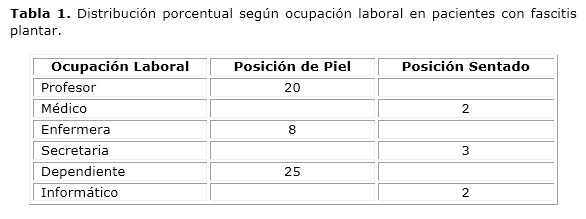Plantar fasciitis
Keywords:
Plantar fasciitis, Occupational diseases.Abstract
Introduction: plantar fasciitis is inflammation of the thick tissue that occupies the front of the inner tubercle of the calcaneus and is the most common cause of pain in the soles of the feet and seriously hampers the individual's work performance.Objective: to characterize the plantar fasciitis in patients assisted in the services of Abel Santamaria Cuadrado General Teaching Hospital of Pinar del Río.
Material and methods: descriptive, longitudinal research implemented in the Department of Physical Medicine and Rehabilitation of Abel Santamaria Cuadrado Hospital in the period from April 2013 to April 2014, patients diagnosed with plantar fasciitis. The universe coincided with the sample (60 patients).
Results: the sample was distributed according to occupation, as long as 53 remain standing, the most dominant female that the male and the average age most affected is 40-49 years. 70.0% of patients showed pain of moderate to severe categories.
Conclusions: overweight and obesity create additional stress. Other factors to consider are the neuropathies, alcohol abuse and heredity.
Downloads
References
1. Rumbaut Reyes M, Cañizares Betancourt D, Cuní Frontera R, Uranga Gafa JC, García Fresnillo E. El strapping como coadyuvante en el tratamiento ortopédico de la fascitis plantar. Rev Haban Cienc Méd[Internet]. 2009 Jun[citado 21 Mar 2014]; 8(2): [aprox. 7 p.]. Disponible en: http://scielo.sld.cu/scielo.php?script=sci_arttext&pid=S1729-519X2009000200018&lng=es
2. USA. Biblioteca nacional de Medicina. Fascitis plantar [Internet]. USA: MedlinePlus. Disponible en: http://www.nlm.nih.gov/medlineplus/spanish/ency/article/007021.htm [citado 05 Sep 2014]
3. Su Jin L, Jung Ho K, Ja Young K, Jin Hong K, Seo Ra Y, Kwang Ik J. Dose-Related Effect of Extracorporeal Shock Wave Therapy for Plantar Fasciitis. Ann Rehabil Med [Internet]. 2013 jun[citado 21 mar 2014]; 37(3): [aprox. 10 p.]. Disponible en: http://www.ncbi.nlm.nih.gov/pmc/articles/PMC3713295/
4. Madrid: Instituto Terapéutico. Guía Terapéutica e Imán terapia Basa. España: Editorial Mir; 1986: 123-7.
5. Diccionario de fisioterapia JIMS. Barcelona: JIMS Malees; 2006.
6. Torrijos A, Abián-Vicén J, Abián P, Abián M. Plantar fasciitis treatment. Journal of Sport and Health Research[Internet]. 2009[citado 22 Ene 2014]; 1(2): [aprox. 9 p.]. Disponible en: http://www.journalshr.com/papers/Vol%201_N%202 /V01_2_6.pdf
7. Tahririan MA, Motififard M, Tahmasebi MN, Siavashi B. Plantar fasciitis. J Res Med Sci[Internet]. 2012 Aug[citado 21 Mar 2014]; 17(8): 799-804. Disponible en: http://www.ncbi.nlm.nih.gov/pmc/articles/PMC3687890/
8. USA. American Academy of Family Physicians. Fascitis plantar: Causas y factores de riesgo[Internet]. USA: AAFP; 2014. Disponible en: http://es.familydoctor.org/familydoctor/es/diseases-conditions/plantar-fasciitis/causes-risk-factors.html [citado 22 Ene 2014]
9. Vásquez B, Coronado JC. Morfometría de los Ramos Nerviosos para los Músculos Interóseos Plantares del Pie en el Hombre. Int J Morphol[Internet].2011 mar[citado 24 mar 2014]; 29(1): [aprox. 5 p.]. Disponible en: http://www.scielo.cl/scielo.php?script=sci_arttext&pid=S0717-95022011000100013&lang=pt
10. Ribeiro AP, Trombini Souza F, Tessutti V, Rodrigues Lima F, I de C Neves Sacco I de C, Amado João SM. Rearfoot alignment and medial longitudinal arch configurations of runners with symptoms and histories of plantar fasciitis. Clinics (Sao Paulo)[Internet]. 2011 Jun[citado 24 Mar 2014]; 66(6): [aprox. 11 p.]. Disponible en: http://www.ncbi.nlm.nih.gov/pmc/articles/PMC3129964/

Published
How to Cite
Issue
Section
License
Authors who have publications with this journal agree to the following terms: Authors will retain their copyrights and grant the journal the right of first publication of their work, which will be publication of their work, which will be simultaneously subject to the Creative Commons Attribution License (CC-BY-NC 4.0) that allows third parties to share the work as long as its author and first publication in this journal are indicated.
Authors may adopt other non-exclusive license agreements for distribution of the published version of the work (e.g.: deposit it in an institutional telematic archive or publish it in a volume). Likewise, and according to the recommendations of the Medical Sciences Editorial (ECIMED), authors must declare in each article their contribution according to the CRediT taxonomy (contributor roles). This taxonomy includes 14 roles, which can be used to represent the tasks typically performed by contributors in scientific academic production. It should be consulted in monograph) whenever initial publication in this journal is indicated. Authors are allowed and encouraged to disseminate their work through the Internet (e.g., in institutional telematic archives or on their web page) before and during the submission process, which may produce interesting exchanges and increase citations of the published work. (See The effect of open access). https://casrai.org/credit/


